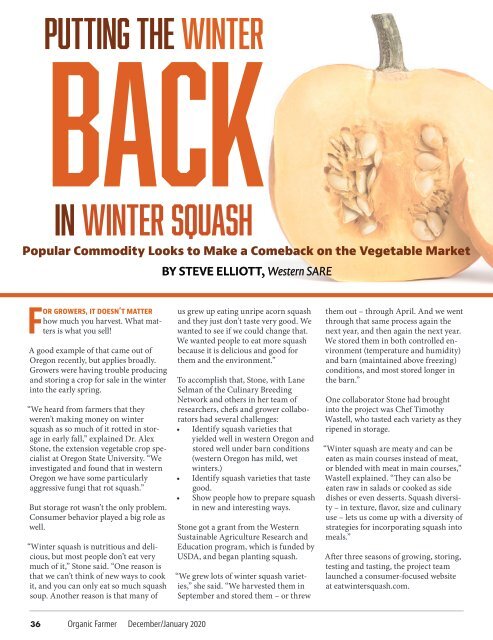OF Dec Jan 2020
You also want an ePaper? Increase the reach of your titles
YUMPU automatically turns print PDFs into web optimized ePapers that Google loves.
Putting the Winter<br />
Back<br />
in Winter Squash<br />
Popular Commodity Looks to Make a Comeback on the Vegetable Market<br />
BY STEVE ELLIOTT, Western SARE<br />
For growers, it doesn’t matter<br />
how much you harvest. What matters<br />
is what you sell!<br />
A good example of that came out of<br />
Oregon recently, but applies broadly.<br />
Growers were having trouble producing<br />
and storing a crop for sale in the winter<br />
into the early spring.<br />
“We heard from farmers that they<br />
weren’t making money on winter<br />
squash as so much of it rotted in storage<br />
in early fall,” explained Dr. Alex<br />
Stone, the extension vegetable crop specialist<br />
at Oregon State University. “We<br />
investigated and found that in western<br />
Oregon we have some particularly<br />
aggressive fungi that rot squash.”<br />
But storage rot wasn’t the only problem.<br />
Consumer behavior played a big role as<br />
well.<br />
“Winter squash is nutritious and delicious,<br />
but most people don’t eat very<br />
much of it,” Stone said. “One reason is<br />
that we can’t think of new ways to cook<br />
it, and you can only eat so much squash<br />
soup. Another reason is that many of<br />
us grew up eating unripe acorn squash<br />
and they just don’t taste very good. We<br />
wanted to see if we could change that.<br />
We wanted people to eat more squash<br />
because it is delicious and good for<br />
them and the environment.”<br />
To accomplish that, Stone, with Lane<br />
Selman of the Culinary Breeding<br />
Network and others in her team of<br />
researchers, chefs and grower collaborators<br />
had several challenges:<br />
• Identify squash varieties that<br />
yielded well in western Oregon and<br />
stored well under barn conditions<br />
(western Oregon has mild, wet<br />
winters.)<br />
• Identify squash varieties that taste<br />
good.<br />
• Show people how to prepare squash<br />
in new and interesting ways.<br />
Stone got a grant from the Western<br />
Sustainable Agriculture Research and<br />
Education program, which is funded by<br />
USDA, and began planting squash.<br />
“We grew lots of winter squash varieties,”<br />
she said. “We harvested them in<br />
September and stored them – or threw<br />
them out – through April. And we went<br />
through that same process again the<br />
next year, and then again the next year.<br />
We stored them in both controlled environment<br />
(temperature and humidity)<br />
and barn (maintained above freezing)<br />
conditions, and most stored longer in<br />
the barn.”<br />
One collaborator Stone had brought<br />
into the project was Chef Timothy<br />
Wastell, who tasted each variety as they<br />
ripened in storage.<br />
“Winter squash are meaty and can be<br />
eaten as main courses instead of meat,<br />
or blended with meat in main courses,”<br />
Wastell explained. “They can also be<br />
eaten raw in salads or cooked as side<br />
dishes or even desserts. Squash diversity<br />
– in texture, flavor, size and culinary<br />
use – lets us come up with a diversity of<br />
strategies for incorporating squash into<br />
meals.”<br />
After three seasons of growing, storing,<br />
testing and tasting, the project team<br />
launched a consumer-focused website<br />
at eatwintersquash.com.<br />
36 Organic Farmer <strong>Dec</strong>ember/<strong>Jan</strong>uary <strong>2020</strong>


















